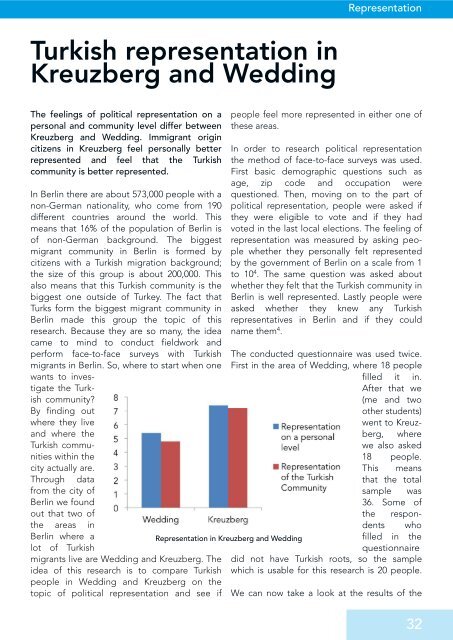Immigration in Berlin
A collection of scientifically-inspired articles written by the students of the course Immigration in Electoral Democracies at the Humboldt - Universität zu Berlin (Summer Semester 2015)
A collection of scientifically-inspired articles written by the students of the course Immigration in Electoral Democracies at the Humboldt - Universität zu Berlin (Summer Semester 2015)
You also want an ePaper? Increase the reach of your titles
YUMPU automatically turns print PDFs into web optimized ePapers that Google loves.
Representation<br />
Turkish representation <strong>in</strong><br />
Kreuzberg and Wedd<strong>in</strong>g<br />
The feel<strong>in</strong>gs of political representation on a<br />
personal and community level differ between<br />
Kreuzberg and Wedd<strong>in</strong>g. Immigrant orig<strong>in</strong><br />
citizens <strong>in</strong> Kreuzberg feel personally better<br />
represented and feel that the Turkish<br />
community is better represented.<br />
In Berl<strong>in</strong> there are about 573,000 people with a<br />
non-German nationality, who come from 1 90<br />
different countries around the world. This<br />
means that 1 6% of the population of Berl<strong>in</strong> is<br />
of non-German background. The biggest<br />
migrant community <strong>in</strong> Berl<strong>in</strong> is formed by<br />
citizens with a Turkish migration background;<br />
the size of this group is about 200,000. This<br />
also means that this Turkish community is the<br />
biggest one outside of Turkey. The fact that<br />
Turks form the biggest migrant community <strong>in</strong><br />
Berl<strong>in</strong> made this group the topic of this<br />
research. Because they are so many, the idea<br />
came to m<strong>in</strong>d to conduct fieldwork and<br />
perform face-to-face surveys with Turkish<br />
migrants <strong>in</strong> Berl<strong>in</strong>. So, where to start when one<br />
wants to <strong>in</strong>vestigate<br />
the Turkish<br />
community?<br />
By f<strong>in</strong>d<strong>in</strong>g out<br />
where they live<br />
and where the<br />
Turkish communities<br />
with<strong>in</strong> the<br />
city actually are.<br />
Through<br />
data<br />
from the city of<br />
Berl<strong>in</strong> we found<br />
out that two of<br />
the areas <strong>in</strong><br />
Berl<strong>in</strong> where a<br />
lot of Turkish<br />
migrants live are Wedd<strong>in</strong>g and Kreuzberg. The<br />
idea of this research is to compare Turkish<br />
people <strong>in</strong> Wedd<strong>in</strong>g and Kreuzberg on the<br />
topic of political representation and see if<br />
people feel more represented <strong>in</strong> either one of<br />
these areas.<br />
In order to research political representation<br />
the method of face-to-face surveys was used.<br />
First basic demographic questions such as<br />
age, zip code and occupation were<br />
questioned. Then, mov<strong>in</strong>g on to the part of<br />
political representation, people were asked if<br />
they were eligible to vote and if they had<br />
voted <strong>in</strong> the last local elections. The feel<strong>in</strong>g of<br />
representation was measured by ask<strong>in</strong>g people<br />
whether they personally felt represented<br />
by the government of Berl<strong>in</strong> on a scale from 1<br />
to 1 0 4 . The same question was asked about<br />
whether they felt that the Turkish community <strong>in</strong><br />
Berl<strong>in</strong> is well represented. Lastly people were<br />
asked whether they knew any Turkish<br />
representatives <strong>in</strong> Berl<strong>in</strong> and if they could<br />
name them 4 .<br />
The conducted questionnaire was used twice.<br />
First <strong>in</strong> the area of Wedd<strong>in</strong>g, where 1 8 people<br />
filled it <strong>in</strong>.<br />
After that we<br />
(me and two<br />
other students)<br />
went to Kreuzberg,<br />
where<br />
we also asked<br />
1 8 people.<br />
This means<br />
that the total<br />
sample was<br />
36. Some of<br />
the respondents<br />
who<br />
filled <strong>in</strong> the<br />
questionnaire<br />
did not have Turkish roots, so the sample<br />
which is usable for this research is 20 people.<br />
Representation <strong>in</strong> Kreuzberg and Wedd<strong>in</strong>g<br />
We can now take a look at the results of the<br />
32


